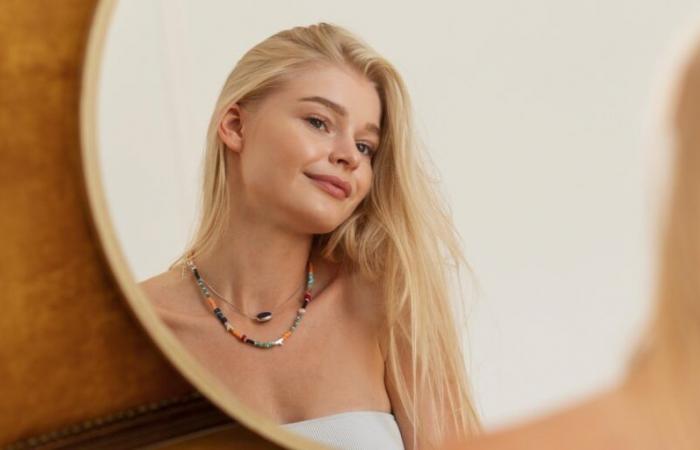TikTok is constantly seeing new beauty trends emerge, but this might just be one of the worst yet. The “Cortisol Face” highlights a growing obsession with the appearance of the face, especially when it is puffy or marked by fatigue. Some beauty influencers track even the slightest roundness, attributing these changes to stress and its supposed effect on the build-up of cortisol, the stress hormone. But behind this trend lies a pernicious mechanism, a sort of “new aesthetic imperative” which encourages a constant race for an ever thinner, ever more “sculpted” face. At the house of The Body Optimistwe say stop this toxic injunction and the complexes it creates! Here's how to escape this toxic TikTok trend and love your face just the way it is.
The “Cortisol Face”, where does it come from?
The “Cortisol Face”, or “moon face”, is a term increasingly used on TikTok to describe a face that would be “puffy” due to excess cortisol, the stress hormone. Followers of this trend in fact refer to cortisol as the villain responsible for their appearance when they feel less good about themselves, their face sometimes appearing a little rounder, perhaps a little puffy when they wake up.
In reality, there is no health aspect in the TikTok videos that address this phenomenon. Beauty influencers see this as an opportunity to add new aesthetic obsession to the long list already present on the platform. They then film themselves testing all kinds of techniques to “deflate” their face and avoid that dreaded look. In just a few clicks, we discover another standard of beauty that fuels anxiety around appearance.
Recommended techniques for “avoid cortisol face” are also symptomatic of this fixation. Influencers on TikTok recommend gua sha (a facial massage tool), draining massages for the face, or even strict anti-stress rituals aimed at regulating cortisol levels. These methods are sold as “beauty tips”, but they amplify a worrying message : that the natural face is not good enough as it is. These videos, so well edited and attractive, ultimately make you believe that everyone should aspire to an angular and thin faceerasing round or natural features; when in reality, the faces are diverse and should be able to exist without this kind of judgment.
Why is this trend toxic?
Behind theapparent lightness of this trend, we find several toxic dynamics. First, it is based on the idea that the “perfect” face is a thin face, without swelling or rounded features. Then she sends a implicit message : If your face changes shape depending on your level of stress or fatigue, this is something youit is necessary to “repair”. This type of discourse fuels a vicious circle, where we constantly seek to improve ourselves, without ever being able to simply be ourselves.
The truth is that the human faces are not fixed. They change depending on emotions, fatigue, diet, and many other factors. By pursuing this type of inaccessible ideal, followers of the “Cortisol Face” condemn themselves to a permanent dissatisfactionbecause the perfect and immutable face simply does not exist.
Instead of sinking into this new injunction, why not opt for a more kind approach towards oneself ? Here are some tips for putting things into perspective, letting go, and learning to accept your face, whatever its condition.
Understand that facial diversity is normal
Our faces are as unique as our footprints digital. Some people have naturally rounder or more angular faces. And all faces can change slightly depending on hormonal cycles, the weather, or even sleep. Instead of fighting against nature, it is important to realize that this diversity is beautiful and is part of what makes us unique.
Taking a step aside from the imposed standards
Social networks, TikTok in the lead, can give the impression that everyone has a smooth and perfectly symmetrical face. In reality, the filterscamera angles, and strict routines contribute to a biased image of reality. Try to remember that behind every video, there are often hours of preparation or effects that change people's appearance.
Rethinking the notion of beauty
Beauty is a concept subjectif which changes from one culture to another, from one era to another. If today we favor sculpted faces, it has not always been this way, and this will change again. Rather than following fluctuating standards, consider explore your own design beauty and to express it freely, without worrying about trends.
Practice gratitude towards your body and face
Gratitude can transform our perception of ourselves. Instead of focusing on the parts of your face you'd like to change, take a moment to enjoy everything your body allows you to do. Your face reflects your emotions, allows you to communicate and feel. This more positive approach makes it possible to create a healthier relationship with your reflection.
Avoid comparisons
On TikTok or elsewhere, it’s easy to fall into constant comparison. But remember that what you see online is often carefully selected and edited. Your beauty is uniqueand it should not be compared to others. Disconnect from the networks for a bit if you feel that it makes you anxious, and focus on reality around you.
Turning to well-being practices without aesthetic objectives
Facial massages and relaxation techniques are great for well-being, but they don't have no need to be motivated by a quest of “deflation”. Consider these rituals as moments of relaxation that make you feel better, rather than a way to change the way you look. Take advantage of it to release tension and take care of yourself, for your own well-being, and not to meet an aesthetic standard.
The “Cortisol Face” trend is one example among many of these new aesthetic pressures emerging from social networks. But it is possible to choose another path, that of self-acceptance. Your features are a reflection of your history, your emotions, and deserve to be appreciated for what they are, without forced adjustment or quest for perfection! Appreciate your reflection, make peace with it.






